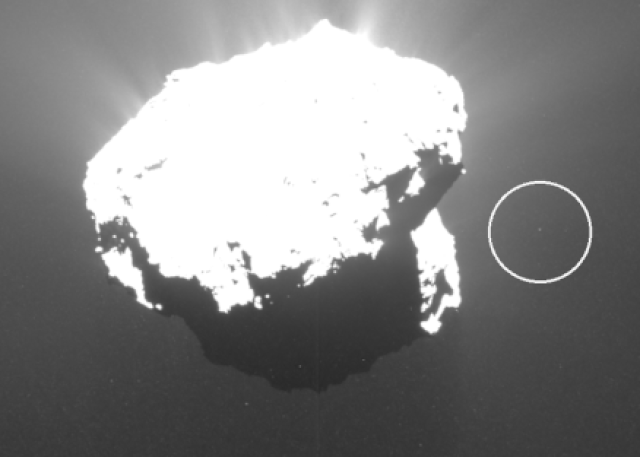Salty space rock helps to solve longstanding comet mystery
Scientists have located the "missing" nitrogen in comets.

Researchers have identified nitrogen previously thought to be "missing" in comets, helping to solve a longstanding mystery about the icy space rocks.
In analyzing the Comet 67P/Churyumov-Gerasimenko, which was visited and studied by the European Space Agency's Rosetta spacecraft, scientists have uncovered significant amounts of ammonium salts that ended up revealing this "missing" nitrogen.
Our solar system — which includes our sun and all of the planets and objects like comets and asteroids — formed from the condensation of a gaseous cloud known as the solar nebula. Scientists have long thought that the nitrogen-to-carbon ratio (N/C) of the sun should be roughly the same in comets, which formed in the cold outer reaches of the solar nebula far from the sun.
Related: See a comet cat in this 70,000-photo Rosetta archive
However, up until now, scientists studying comets (including 67/P) found that there was less nitrogen than they expected. They didn't know where the "missing" nitrogen might be or why the N/C ratio was not consistent with their expectations.
In a new study, a team led by Olivier Poch, a post-doctoral researcher working at the Institut de Planétologie et d'Astrophysique de Grenoble in France, created simulated comets, or fake comets, in a lab experiment. They simulated a variety of possible comet surface compositions.
The team didn't intend to solve the mystery of the missing nitrogen in comets when they started: They actually wanted to figure out what compounds are present in the comet's surface material that have produced infrared absorption bands. These bands are a strange feature on the surface of 67P that absorb a spectrum of light around the 3.2-micrometer (μm) wavelength. In other words, this feature absorbs light at a specific wavelength because of the compounds in the material there.
Get the Space.com Newsletter
Breaking space news, the latest updates on rocket launches, skywatching events and more!
While the team tested a number of compounds within these simulations, they found that the best match, or the compound that best produced the same absorption effect as there is on Comet 67P, was one that had nitrogen-containing ammonium salts. Because these salts could reproduce the banded feature on Comet 67P, they concluded that this compound is likely the source of the feature.
However, as Poch told Space.com, while "most of the absorption bands is ammonium salts … there are other constituents that also contribute to this band." So, while in their simulation they identified this compound as the source of the feature, Poch noted that Comet 67P also has water ice and organic matter that they didn't model in their simulation, so the simulation wasn't exactly like the real comet. Poch also added that there is likely a mixture of a number of different types of ammonium salts that are present in 67P's surface material.
While "this is the first time we detect its [nitrogen's] source on a comet," Poch said, a team making observations with Rosetta identified ammonium salts on the comet earlier this year. As Poch explained, dust grains found their way inside of the mass spectrometer instrument aboard the craft and the team saw a huge amount of ammonia. And, since ammonium salts can decompose into ammonia, this other study supports the findings of Poch and his team.
The scientists not only have found evidence of the source of this mysterious feature, by identifying a nitrogen-containing compound, they have also uncovered some "missing" nitrogen on 67P. It has yet to be seen whether the amount of nitrogen they detected is enough to fully account for the N/C ratio discrepancy.
"We cannot quantify exactly the amount of ammonium salt on the comet, so we can say there is more nitrogen in this comet than previously thought, but we don't know exactly how much," Poch said.
These findings have not only added to our understanding of how and why there is nitrogen in comets, they could also add to our understanding of how nitrogen may have been carried to early Earth on space rocks like Comet 67P.
This work was published Thursday (March 12) in the journal Science.
- Photos: Europe's Rosetta Comet Mission in Pictures
- Surprise! Scientists Recover Rosetta Spacecraft's Last Photo of Comet 67P
- The Truth Behind This Amazing Video from the Surface of a Comet
Follow Chelsea Gohd on Twitter @chelsea_gohd. Follow us on Twitter @Spacedotcom and on Facebook.
OFFER: Save at least 56% with our latest magazine deal!
All About Space magazine takes you on an awe-inspiring journey through our solar system and beyond, from the amazing technology and spacecraft that enables humanity to venture into orbit, to the complexities of space science.
Join our Space Forums to keep talking space on the latest missions, night sky and more! And if you have a news tip, correction or comment, let us know at: community@space.com.

Chelsea “Foxanne” Gohd joined Space.com in 2018 and is now a Senior Writer, writing about everything from climate change to planetary science and human spaceflight in both articles and on-camera in videos. With a degree in Public Health and biological sciences, Chelsea has written and worked for institutions including the American Museum of Natural History, Scientific American, Discover Magazine Blog, Astronomy Magazine and Live Science. When not writing, editing or filming something space-y, Chelsea "Foxanne" Gohd is writing music and performing as Foxanne, even launching a song to space in 2021 with Inspiration4. You can follow her on Twitter @chelsea_gohd and @foxannemusic.










